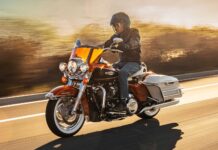Let me be clear from the outset—this is philosophy, pure and simple. It has little to do with Harleys directly, but it could—too easily, actually—if there’s ever any incident, let alone accident, with press attention directed that way. What it does have to do with is fundamental ignorance, lack of skills, media hype, then last and least, mechanical gremlins (mythical creatures, incidentally). I speak, of course, of recalls in general and specifically those afflicting Toyota of late. What pushed me over the edge (and into your face) was today’s breaking news about some doofus in an “out-of-control” Prius who went over 30 miles at speeds up to 90-plus, before calling 911 (on his cell phone!) and being “talked down” to a stop by cops on bull horns telling him how to use his brakes. It got to me! Mainly, because I think Toyota is taking an undeserved beating for (over) doing the right thing and because it’s simply facile to presume recalling 8.5 million vehicles to prevent cage drivers from spilling their lattes isn’t just the tip of an iceberg of bullshit! Was this a sheer fluke, an isolated instance of poor maintenance, a grandstand play to dump a car no longer wanted, or foreshadowing of yet another chapter in the saga? Why didn’t this character understand how to stop his car? Car and Driver magazine (March 2010 issue) explains the process pretty well. Are we honestly supposed to swallow the story that his car mysteriously decided to take off on its own with no input and resisted all attempts to stop it—out of the blue? Besides, defect or not, where does the ultimate responsibility for vehicle control (let alone safety) really reside?
Before we deal with the current issues of alleged SUA (so-called “sudden unintended acceleration”) and any (if any) braking deficiencies, I’d like to offer a little recap of how recalls and the NHTSA (National Highway Traffic Safety Administration, or “nutsa” as I like to call ’em) came to exist in the first place. In other words, before we get going too fast, let’s back up a bit.
In the early 1960s when 85 percent of all cars on the road came from the Big Three (and Oriental meant food), the USA had better safety performance than any other nation on earth no matter how it was measured. Yet, we had no safety equipment or standards as we know them today, so let’s start there. No—check that—let’s start with Ralph Nader’s attack on the most original and unique automotive design since the post-war Tucker… the Chevy Corvair. Whether or not you give a crap about ’Vairs (or Chevys, for that matter), the fact remains that after all the bally-hoo brought to bear by Unsafe At Any Speed subsided, we had a good car killed off, a media uproar based on sensationalism more than substance, government bureaucracy of questionable merit and unlimited authority, and a bunch of new rules regarding the way all vehicles could and would be constructed if they were to be sold in this country. Like Prohibition (which left a lasting legacy of organized crime and denial of human nature when it comes to adult beverages), I hold that this has effectively left us with more harm than good and with something less than total freedom of choice in our vehicles in exchange for making us more safe… theoretically.
Would it surprise you to know it hasn’t really worked? We might indeed be safer than we were in the “dark ages” of the ’60s—progress is progress after all—but percentage-wise it goes more like this:
| 1979 FATALITIES |
2002 FATALITIES |
PERCENT CHANGE | |
| United States |
51,093 | 42,815 | -16.2% |
| Great Britain | 42,815 | 3,431 | -46.0% |
| Canada | 5,863 | 2,936 | -49.9% |
| Australia | 3,508 | 1,715 | -51.1% |
A statistical snapshot like this, leads to natural curiosity about why we fare so poorly, relative to other civilized cultures—don’t it? What’s the big difference between us and them… aside from the fact that “they” improve vehicles (and roads and drivers) according to a yardstick of common sense, whilst we meekly succumb to Federal mandates?
One obvious detail is that we, as a nation, drive way more pickup trucks and SUVs, a debatable point that can be argued from both sides. One side believes firmly that more molly-coddling of motorists with huge road tanks, sporting ever more air bags and seat belts and technological advances such as anti-lock brakes, traction control, low tire pressure warning systems and the like—is certainly safest. After all, smacking into one another as we do, you’d really want all that ponderous mass to cocoon the occupants and keep them from harm when carelessly crushing all those dangerous little compact cars and motorcycles… now wouldn’t we? The other side argues with equal conviction that SUVs, and especially pickups, are significantly less safe from virtually every other thing but collisions and they have the statistics to prove that, too. Not least, they note sheer numbers of the things on our roads (over half of all vehicles here), pointing out by contrast that countries without ’em have fewer fatalities. Simple… innit?
Trouble is—no matter which side of the statistical coin you flip to, this whole safety thing ignores what I choose to call our national Operator IQ, which is painfully low on several levels. Let me be clear (if that’s possible) that I’m not saying Americans are dumb, rather it’s that U.S. drivers are amazingly ignorant and unskilled—on the whole. Just the fact that we let anyone drive anything in this country, yet consider the act of driving (or riding) a privilege should tell you something about how screwed up our OIQ really is! But without any sort of effective training and/or graduated licensing programs, such as they have in virtually all those statistically safer nations, you can see how the focus has just possibly been on the wrong part of the big picture, after all.
I have always maintained that (up to the point of impact) motorcycles are inherently safer than any vehicle with four wheels. I also firmly believe that a properly trained and experienced pilot is at least half the total equation in what is, of necessity, the synergistic package that vehicle and operator create. This is perhaps an awkward way to point out that you simply cannot separate one from the other when it comes to insights regarding the effectiveness, function and (Yup!) safety of any vehicle. In a sort of bi-polar fashion, I’d like to suggest that the motorcycling community is more or less at the proficient pole and Toyota drivers (apparently) typify the other. Not that all car drivers aren’t nearly as bad, or that all Toyota drivers are terrible (I drive one, damn it) but, generally speaking, the reason we were safer in the ’60s was our more defensive driving habits—not our cars or motorcycles. As a breed, U.S. vehicle pilots of all kinds and stripes have simply been lulled into a false sense of technological security (and safety) over the last 40 years!
Here’s why: Remember the Corvair flap we were referring to earlier? You know how many fatalities were ultimately, factually, attributed to this supposed safety disaster of a car? None… not one! Zero! Zip! Nada! It was media hysteria all along. Same thing, with Audi’s go ’round with SUA, thanks to a 60 Minutes story in the ’80s, which as it turned out was also BS! Yet Audi suffered horrendously from this “nothing” for years. Ford and Firestone split the sheets after a century of good relations over the notion that Explorers were flipping over because the tires were no good. The tires were fine—as long as you kept air in ’em, yet thanks to this virtually nonexistent problem, unnecessary damage was done there too! Now it’s Toyota’s turn—and make no mistake, next week it could be Harley-Davidson.
All these scenarios—historic, current and potential—have some common denominators. These seem to me, in order, to be: a characteristic of the vehicle rightly or wrongly being interpreted as a problem, a society that doesn’t know (or want to know) anything until the poop flies off the shovel courtesy of hysterical and often irresponsible media shouting, and a legal morass of class action suits from folks who want in on any knee-jerk reaction that might result in a pay-off.
Technically, Toyotas and Harleys have a couple things in common that are implicit in this debacle, namely fly-by-wire throttles and electronic cruise control. The votes aren’t all in on the root of SUA in the recalled cars, but I’ll go to the mat defending the notion it is not either of those. However, most of the sensationalists out there refuse to believe that the logical culprit in Toyota’s case is simply corrosion of the pedal pivot and the fix (a plastic “patch”) is legit and sufficient. The uninformed masses, true to the theory of fearing what they know nothing of, want to pin it on the inviolate computer that controls the engine and steadfastly, ignorantly, refuse any other explanation. Come on! Any old-time Harley riders out there wanna take a bet that a throttle cable will kink, stick and cause SUA issues of its own—way before the same thing could ever happen to the FBW throttle of a Twin Cam Tourer? Thought not!
That simple example of old versus new technologies on hogs should indicate how these things can get overblown by paranoids (number one) and (number two) why we proficient Harley riders at least learn where the kill button is and how to operate it—just in case! We also tend to understand it’s not any amount of electronic nannies, belts and bags… ’cause they can only assist in keeping us safe. We bikers know that even if a throttle sticks wide open, the button, clutch and brakes (along with our defensive driving tricks) are what keep us alive and out of trouble. Apparently that’s more than you can say for a doofus in a Prius!
Look, I’ll freely admit separating wheat from chaff on these kinds of issues frequently leads into a minefield for the layman, since you cannot discount real safety hazards (like exploding Pinto gas tanks). Yet more often than not, it’s intentional hype, not accidental hazard that makes the 10 o’clock news. All vehicle manufacturers (including H-D) have issued voluntary recalls in order to improve products and correct flaws once flaws are spotted. Companies like Ford, GM, Firestone, Toyota and—yes—Harley have been around long enough to make it simply illogical to assume they are constantly trying to put one over on consumers. (On the other hand, the media just might be.) More rationally, recalls tend to point out that making legitimate discoveries of issues in the field proves they (and we) are only human, in the end. Since the first recall (for steering gear that broke on 1959 Cadillacs), there have been several thousands, the vast majority of which had nothing to do with potentially fatal flaws. (Unless just getting into a car or astride a motorcycle is something you consider potentially fatal—which it is.) As motorcyclists, we of all people should best appreciate and understand that no amount of technology can protect you from everything that might hurt or kill you on this nation’s roads, and that’s kinda the point.
Refusal to be a technological hostage, continual training, and intentionally ongoing improvement in skills, knowledge, sheer experience and a finely-honed BS detector will always be the safe bet! Because, what keeps you safest—is you!




















